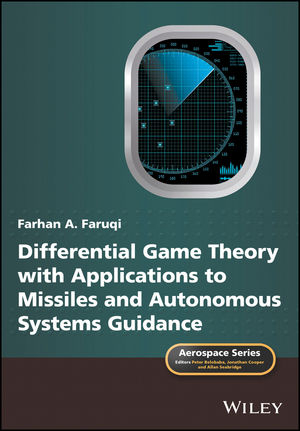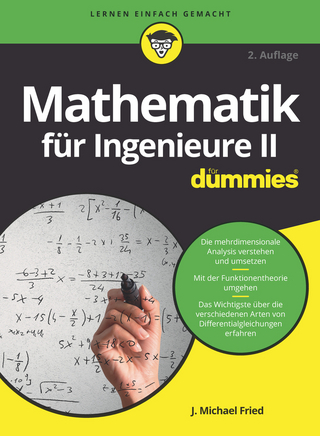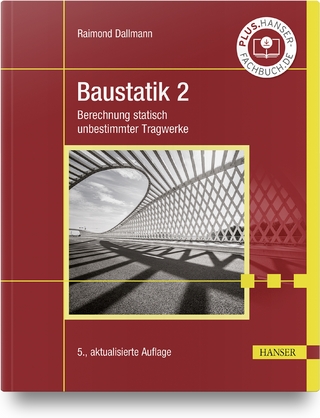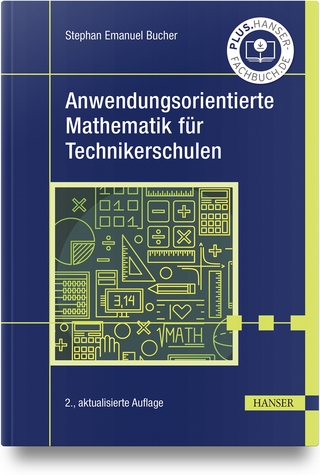
Differential Game Theory with Applications to Missiles and Autonomous Systems Guidance
John Wiley & Sons Inc (Verlag)
978-1-119-16847-8 (ISBN)
Differential Game Theory with Applications to Missiles and Autonomous Systems explains the use of differential game theory in autonomous guidance and control systems.
The book begins with an introduction to the basic principles before considering optimum control and game theory. Two-party and multi-party game theory and guidance are then covered and, finally, the theory is demonstrated through simulation examples and models and the simulation results are discussed. Recent developments in the area of guidance and autonomous systems are also presented.
Key features:
Presents new developments and how they relate to established control systems knowledge.
Demonstrates the theory through simulation examples and models.
Covers two-party and multi-party game theory and guidance.
Accompanied by a website hosting MATLAB® code.
The book is essential reading for researchers and practitioners in the aerospace and defence industries as well as graduate students in aerospace engineering.
Farhan A. Faruqi, Defence Science and Technology Organisation, Australia Professor Dr. Farhan A. Faruqi is the Head of the Intelligent Autonomous Systems Research Guidance and Control Group in the Defence Science and Technology Organisation in Australia. He is also an Adjunct Professor at the University of South Australia. His main areas of expertise include autonomous systems navigation; guidance and control; target tracking; and intelligent autonomous systems. He has more than twenty years' experience in the Aerospace and Defence Industry in the UK, USA, and Australia.
Preface xi
Acknowledgments xiii
About the Companion Website xv
1 Differential Game Theory and Applications to Missile Guidance 1
Nomenclature 1
Abbreviations 2
1.1 Introduction 2
1.1.1 Need for Missile Guidance—Past, Present, and Future 2
1.2 Game Theoretic Concepts and Definitions 3
1.3 Game Theory Problem Examples 4
1.3.1 Prisoner’s Dilemma 4
1.3.2 The Game of Tic-Tac-Toe 6
1.4 Game Theory Concepts Generalized 8
1.4.1 Discrete-Time Game 8
1.4.2 Continuous-Time Differential Game 9
1.5 Differential Game Theory Application to Missile Guidance 10
1.6 Two-Party and Three-Party Pursuit-Evasion Game 11
1.7 Book Chapter Summaries 11
1.7.1 A Note on the Terminology Used In the Book 13
References 14
2 Optimum Control and Differential Game Theory 16
Nomenclature 16
Abbreviations 17
2.1 Introduction 17
2.2 Calculus of Optima (Minimum or Maximum) for a Function 18
2.2.1 On the Existence of the Necessary and Sufficient Conditions for an Optima 18
2.2.2 Steady State Optimum Control Problem with Equality Constraints Utilizing Lagrange Multipliers 19
2.2.3 Steady State Optimum Control Problem for a Linear System with Quadratic Cost Function 22
2.3 Dynamic Optimum Control Problem 23
2.3.1 Optimal Control with Initial and Terminal Conditions Specified 23
2.3.2 Boundary (Transversality) Conditions 25
2.3.3 Sufficient Conditions for Optimality 29
2.3.4 Continuous Optimal Control with Fixed Initial Condition and Unspecified Final Time 30
2.3.5 A Further Property of the Hamiltonian 35
2.3.6 Continuous Optimal Control with Inequality Control Constraints— the Pontryagin’s Minimum (Maximum) Principle 36
2.4 Optimal Control for a Linear Dynamical System 38
2.4.1 The LQPI Problem—Fixed Final Time 38
2.5 Optimal Control Applications in Differential Game Theory 40
2.5.1 Two-Party Game Theoretic Guidance for Linear Dynamical Systems 41
2.5.2 Three-Party Game Theoretic Guidance for Linear Dynamical Systems 44
2.6 Extension of the Differential Game Theory to Multi-Party Engagement 50
2.7 Summary and Conclusions 50
References 51
Appendix 53
3 Differential Game Theory Applied to Two-Party Missile Guidance Problem 63
Nomenclature 63
Abbreviations 64
3.1 Introduction 64
3.2 Development of the Engagement Kinematics Model 67
3.2.1 Relative Engage Kinematics of n Versus m Vehicles 68
3.2.2 Vector/Matrix Representation 69
3.3 Optimum Interceptor/Target Guidance for a Two-Party Game 70
3.3.1 Construction of the Differential Game Performance Index 70
3.3.2 Weighting Matrices S, R p ,R e 72
3.3.3 Solution of the Differential Game Guidance Problem 73
3.4 Solution of the Riccati Differential Equations 75
3.4.1 Solution of the Matrix Riccati Differential Equations (MRDE) 75
3.4.2 State Feedback Guidance Gains 76
3.4.3 Solution of the Vector Riccati Differential Equations (VRDE) 77
3.4.4 Analytical Solution of the VRDE for the Special Case 78
3.4.5 Mechanization of the Game Theoretic Guidance 79
3.5 Extension of the Game Theory to Optimum Guidance 79
3.6 Relationship with the Proportional Navigation (PN) and the Augmented PN Guidance 81
3.7 Conclusions 82
References 82
Appendix 84
4 Three-Party Differential Game Theory Applied to Missile Guidance Problem 102
Nomenclature 102
Abbreviations 103
4.1 Introduction 103
4.2 Engagement Kinematics Model 104
4.2.1 Three-Party Engagement Scenario 105
4.3 Three-Party Differential Game Problem and Solution 107
4.4 Solution of the Riccati Differential Equations 111
4.4.1 Solution of the Matrix Riccati Differential Equation (MRDE) 111
4.4.2 Solution of the Vector Riccati Differential Equation (VRDE) 112
4.4.3 Further Consideration of Performance Index (PI) Weightings 115
4.4.4 Game Termination Criteria and Outcomes 116
4.5 Discussion and Conclusions 116
References 117
Appendix 118
5 Four Degrees-of-Freedom (DOF) Simulation Model for Missile Guidance and Control Systems 125
Nomenclature 125
Abbreviations 126
5.1 Introduction 126
5.2 Development of the Engagement Kinematics Model 126
5.2.1 Translational Kinematics for Multi-Vehicle Engagement 126
5.2.2 Vector/Matrix Representation 128
5.2.3 Rotational Kinematics: Relative Range, Range Rates, Sightline Angles, and Rates 128
5.3 Vehicle Navigation Model 130
5.3.1 Application of Quaternion to Navigation 131
5.4 Vehicle Body Angles and Flight Path Angles 133
5.4.1 Computing Body Rates (p I ,q I ,r I) 134
5.5 Vehicle Autopilot Dynamics 135
5.6 Aerodynamic Considerations 135
5.7 Conventional Guidance Laws 136
5.7.1 Proportional Navigation (PN) Guidance 136
5.7.2 Augmented Proportional Navigation (APN) Guidance 137
5.7.3 Optimum Guidance and Game Theory–Based Guidance 137
5.8 Overall State Space Model 138
5.9 Conclusions 138
References 139
Appendix 140
6 Three-Party Differential Game Missile Guidance Simulation Study 150
Nomenclature 150
Abbreviations 150
6.1 Introduction 151
6.2 Engagement Kinematics Model 151
6.3 Game Theory Problem and the Solution 154
6.4 Discussion of the Simulation Results 157
6.4.1 Game Theory Guidance Demonstrator Simulation 157
6.4.2 Game Theory Guidance Simulation Including Disturbance Inputs 160
6.5 Conclusions 162
6.5.1 Useful Future Studies 162
References 163
Appendix 164
Addendum 165
Index 189
| Erscheinungsdatum | 22.04.2017 |
|---|---|
| Reihe/Serie | Aerospace Series (PEP) |
| Verlagsort | New York |
| Sprache | englisch |
| Maße | 170 x 244 mm |
| Gewicht | 522 g |
| Themenwelt | Mathematik / Informatik ► Mathematik ► Angewandte Mathematik |
| Mathematik / Informatik ► Mathematik ► Finanz- / Wirtschaftsmathematik | |
| Technik ► Elektrotechnik / Energietechnik | |
| Technik ► Maschinenbau | |
| ISBN-10 | 1-119-16847-3 / 1119168473 |
| ISBN-13 | 978-1-119-16847-8 / 9781119168478 |
| Zustand | Neuware |
| Haben Sie eine Frage zum Produkt? |
aus dem Bereich


